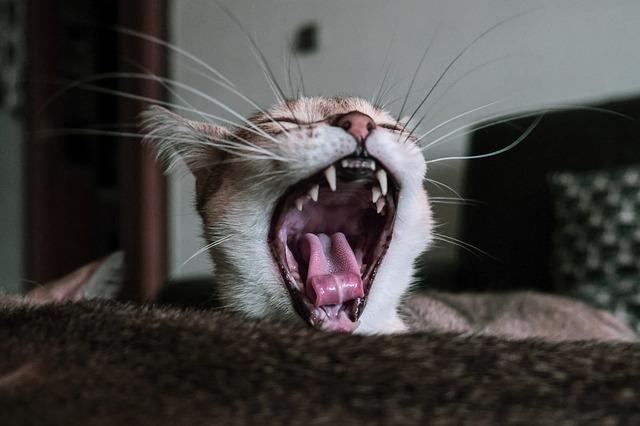
Does your cat's bad breath keep the two of you from snuggling? We take your cat's dental seriously; that is why we have come up with these essential facts that you need to know about oral health in your cat. Please contact us to make an appointment to evaluate your cat's overall dental health.
What is dental disease?
Dental disease is a painful condition that occurs when bacteria, plaque, and tartar buildup on the teeth and get trapped beneath the gum line. The bacteria can be absorbed into the bloodstream and wreak havoc on other major organs throughout the body.
Here are 10 facts you need to know so you can be an advocate for your cat's oral (and overall) health:
- Dental disease begins early in life. By the age of three, most cats have some degree of dental disease. The early signs of dental disease in cats include bad breath, yellow tartar buildup on the teeth, and red and swollen gums. Early detection of your cat's dental disease is vital. If left untreated, it will progress to cause chronic pain and inflammation. To detect dental disease before it negatively affects your cat's quality of life, AAHA (American Animal Hospital Association) recommends dental evaluations as part of your cat's regular preventive care exam, which should take place at least once a year.
- Dental disease causes significant, chronic pain in pets. When dental disease is discovered later, after years of tartar, plaque, and bacteria buildup have caused infection, inflammation, and diseased teeth, your cat, has already experienced significant, chronic, and life-changing pain. But cats are experts at hiding signs of illness, so the pain may go unnoticed by you. Instead, you may see that your cat is increasingly irritable, lethargic and has a decreased appetite—changes you may attribute to your cat's advancing age or other lifestyle factors. But after a proper and thorough dental procedure, many pet owners report the emergence of "a whole new cat"—one who is happier and more active.
- X-rays are essential for diagnosing dental disease. After examining dental radiographs (X-rays) of cats and dogs with teeth that appeared normal to the naked eye, veterinarians found 27.8% of dogs and 41.7% of cats had diseased teeth. In pets with abnormal-looking teeth, veterinarians found additional diseased teeth in 50% of dogs and 53% of cats. At Plymouth Veterinary Hospital, all dental procedures are evaluated with digital dental X-rays. This way, we are better able to diagnose and treat dental disease.
- Anesthesia makes dental evaluation and treatment safer and less stressful for your pet. During your pet's dental procedure, veterinarians and technicians use sharp, sterilized instruments. Animals don't like to hold still while X-rays are taken, and these sharp instruments are used to clean their teeth. Placing your pet under anesthesia during the procedure allows your veterinarian to make a more accurate diagnosis and decrease the chance of complications. Your pet will rest comfortably while the veterinary team safely performs a thorough and proper dental cleaning.
- Anesthesia is much safer than you may think. Before anesthesia, your cat will be carefully screened with bloodwork and other tests to ensure she is free from the underlying disease. During the dental procedure, a trained professional will be dedicated to continuously monitoring, recording vital signs, and communicating the findings to the veterinarian.
- Non-anesthetic dentistry is stressful, unsafe, and ineffective. Imagine multiple strangers holding you down and speaking a language you don't understand. They're shining bright lights in your face and inserting sharp, scary instruments into your mouth that pinch and poke. This is what your cat would endure during a non-anesthetic dental procedure. Without anesthesia, it's impossible to obtain X-rays to see what lies beneath your cat's gumline. It is also impossible to safely and effectively clean the teeth using those sharp instruments while the cat is awake. At Plymouth Veterinary Hospital, all dental procedures are performed under general anesthesia.
- Removing plaque from teeth beneath the gum line is vital. It's even more important than scaling the portion of the teeth we can see. Bacteria thrive under the gumline, causing infections deep in the tooth root and jaw that can spread throughout the body and affect other organs, such as the heart and kidneys.
- Your veterinarian may create a personalized pain protocol to keep your cat comfortable. Although your cat will be anesthetized during tooth extraction, numbing medications will decrease the amount of general anesthetic needed and can last up to eight hours after the procedure, allowing your pet to rest in comfort. Your veterinarian can tailor your cat's prescription pain medication to match the procedure, so she'll recover peacefully at home.
- Homecare is an essential part of taking care of your cat's oral health. Brushing your cat's teeth every day will promote good oral hygiene and prevent potentially expensive surgeries down the road. It's easier than you think: There are even special pet toothpaste flavored like beef, chicken, fish, and peanut butter. (Note: Never use human toothpaste, which can contain ingredients like xylitol that are toxic to animals.) Also, the accumulation of plaque and tartar can be prevented by feeding your cat a special dental diet—food that's specifically designed to help preserve oral health.
- Not all pet dental products are created equal. If you can't brush your cat's teeth as often as you'd like, consider using other dental products designed to help maintain your pet's oral hygiene. At Plymouth Veterinary Hospital, we have products and diets recommended explicitly for cats.
References
- Verstraete FJ, Kass PH, Terpak CH. Diagnostic value of full-mouth radiography in cats. Am J Vet Res 1998;59(6):692–5.
- American Animal Hospital Association. Credit.
